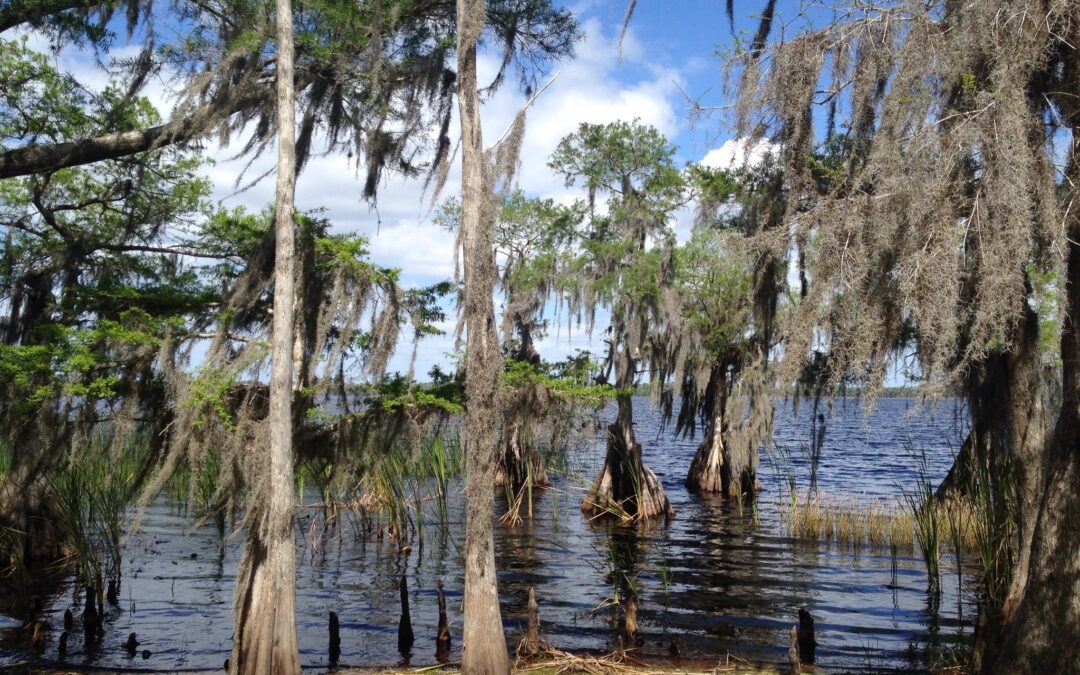
by Scott Martin Photography | Mar 13, 2012 | Blog, Educational, General
The wonderful world of apps for your smartphone has produced thousands of apps for the photographer; some to add quirky text balloons to your pics, some to make you smile by distorting the people in your images but fortunately some provide serious horsepower to improve your images and expanding the versatilty of the smartphone camera. Photosynth and Snapseed are two of the latter and every photographer serious about using your smartphone camera needs these apps.
Photosynth is a free app designed by Microsoft to make the taking of panoramic images a breeze, and it does exactly that. You can take 360 degree panos as well as taking ‘multi-level’ panoramas meaning you can take a matrix of images and have Photosynth seamlessly stitch them together into one image. When viewed in the Photosynth viewer you can use your finger to scan from left and right and up and down within the image. It is very impressive. After saving the panorama to your photostream you can then edit and crop the image using Snapseed. Snapseed is a powerful image editor developed by NIK Software, famous for their suite of plug-ins for Photoshop, Lightroom and Aperture. The beauty of Snapseed is that it brings NIK’s patented U-point technology to the smartphone and tablet. U-point technology allows for selective editing of brightness, contrast and saturation within an image based on the colour and texture of the part of the image you select. Besides selective editing, Snapseed performs many other essential post processing effects including, sharpening, structure, ambiance, white balance, special effect filters and even tilt shift conversions to name just a few. Snapseed costs $4.99 but I can assure you that it will become the only smartphone/tablet photo editor you will use once you have downloaded it.
Here is a photo taken earlier today of Lake Russel in the Disney Nature Conservancy south of Kissimmee Florida. This shot was captured with an iPhone 4S (8 megapixel camera) without any zoom in landscape orientation. The image is un-cropped.
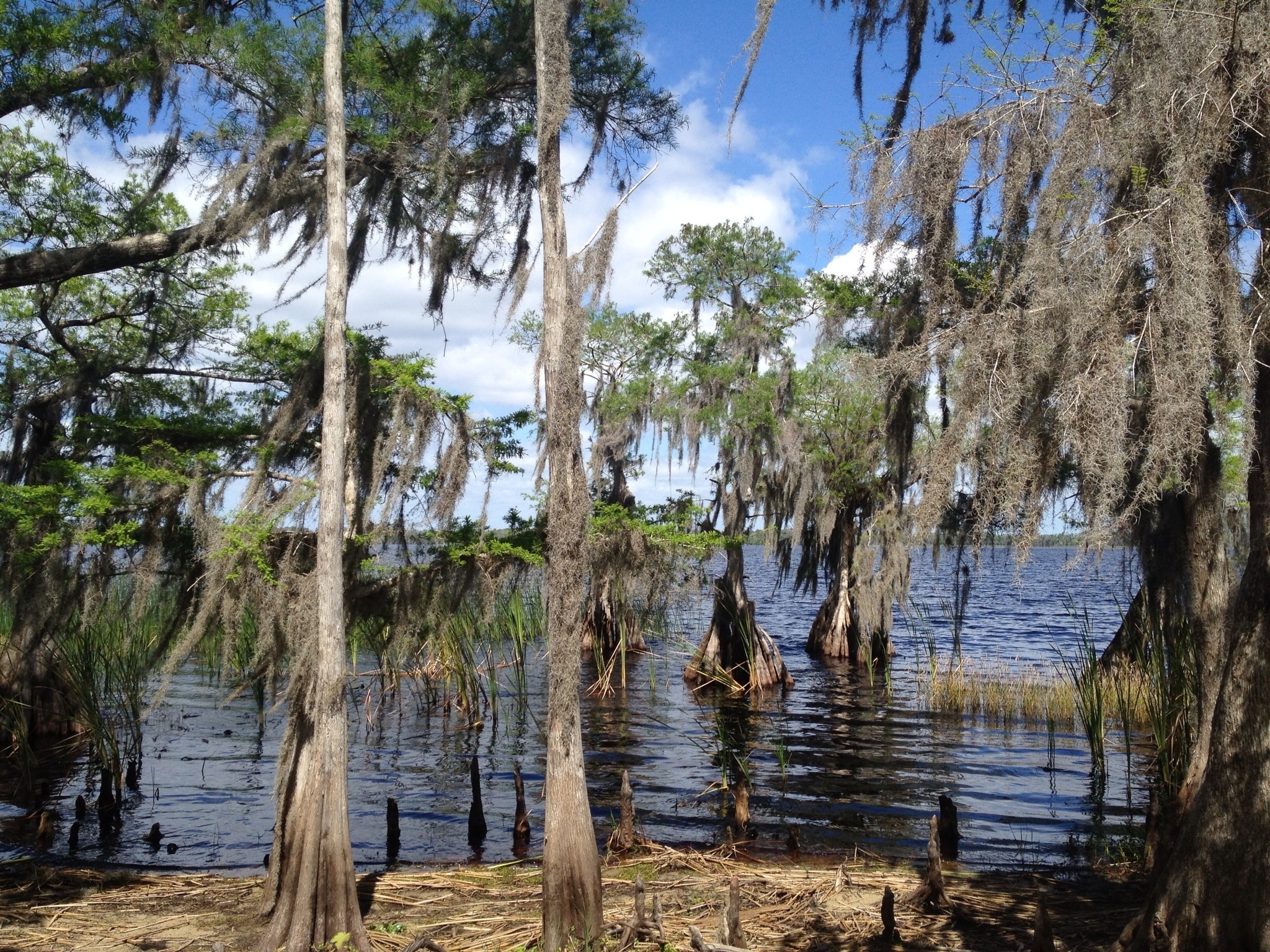
Here is six shot panorama taken from the same position with Photosynth and the camera in portrait orientation. It took Photosynth less than ten seconds to seamlessly stitch the images together. The resultant picture was cropped and edited using Snapseed.

Finally, this is an eighteen image panorama taken as a 6×3 matrix. Photosynth stitched this panorama in about fifteen seconds. This image was taken from the same spot as the previous one and was processed with Snapseed.
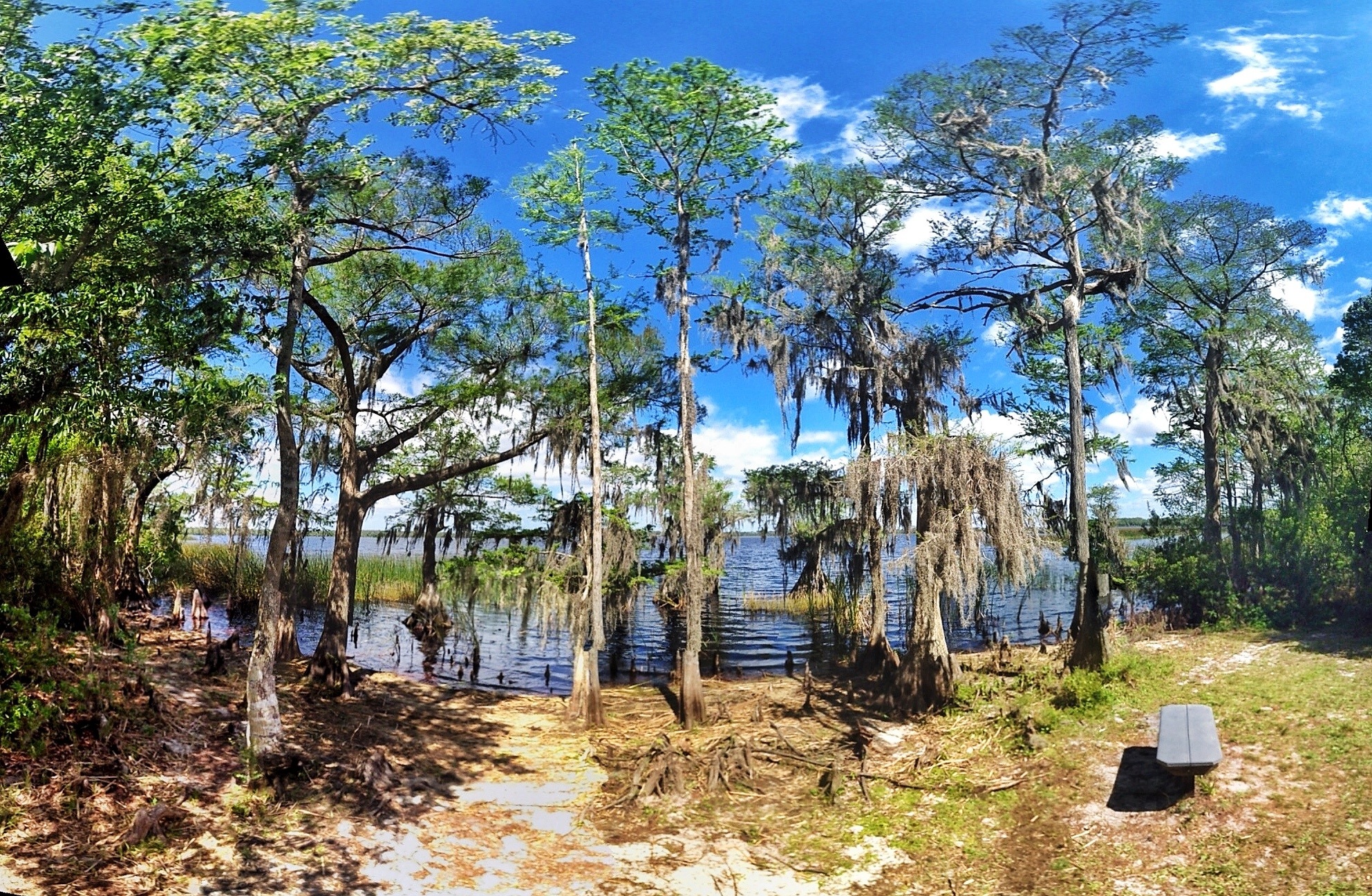
In keeping with the theme of this blog post, it is being written and posted from Florida on an iPad 2 using the WordPress app. The photos, all taken earlier today with an iPhone 4S, showing up on the iPad via the cloud! How technology has changed over the part few years.
I would like to thank my good friend Arni who told me about Photosynth. You can see his superb photography at www.pixelz.ca
Note: After posting the blog images it became apparent that I cannot use the iPad to resize the photos as I usually do with WordPress. Please accept my apologies and I’ll fix the problem when I’m back in front of the computer. In the mean time the new technology still impresses!
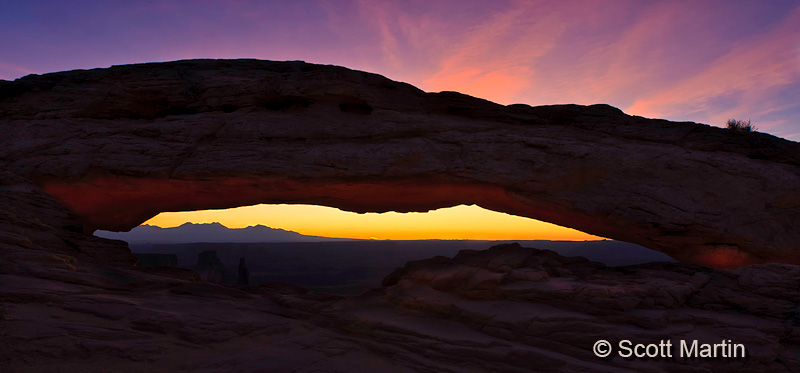
by Scott Martin Photography | Mar 2, 2012 | Blog, Landscapes, Naturescapes, Travel
Photographing the Mesa Arch at sunrise is something every serious landscape photographer wants to do before hanging up the camera gear. In order to be there on time requires a bit of effort however that effort is richly rewarded as you watch the sun break over the horizon and under the arch, illuminating the La Sal mountain range some thirty-five miles away and the Colorado River Basin two thousand feet below. It was 34°F when Deb & I left our hotel in Moab Utah around 4:30 a.m. for the forty mile drive to the Mesa Arch trail head which is in the Island In The Sky region of Canyonlands National Park. From the trailhead we hiked the rather short trail (half of a mile) in the dark but didn’t require flashlights all of the way as the moon light was wonderful that morning. Once we claimed a spot for the tripod and set things up we had about 45 minutes before sunrise during which we got a chance to chat with the twenty or so others who arrived before the sun came up. Make sure to arrive early if you want a good spot!
The exposures for the images posted today range from less than a second to more than thirty seconds and were all taken with a Canon 1D MK III and 16-35/2.8 or 24-105/4 lenses. Most were taken with Lee and Singh-Ray 4×6 ND grad filters.
Before the sunrise.

Sunrise….at one of the prettiest places on earth to watch the sun come up. When photographing sunrises, always use a small aperture of f/18 or smaller which creates the starburst look of the sun. This is true for any bright light source in your image (street lights, stars, Christmas lights, candles etc). If you want the starburst effect, use the smallest aperture possible. This means using a tripod because of the longer exposures required but it is worth the effort and creates excellent results.
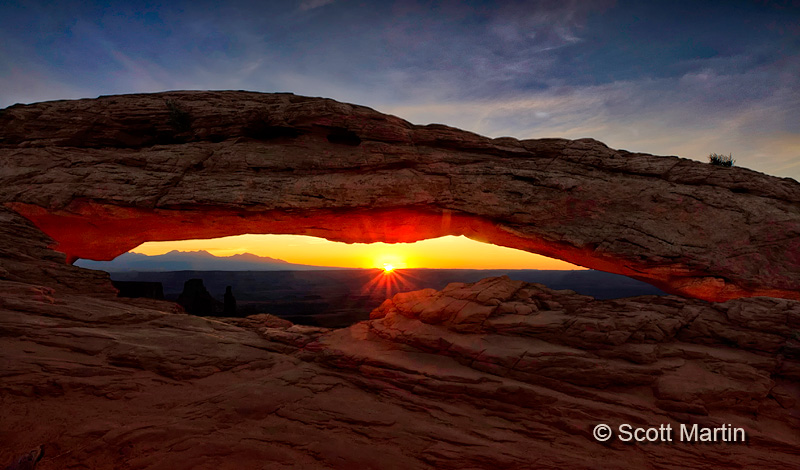
.
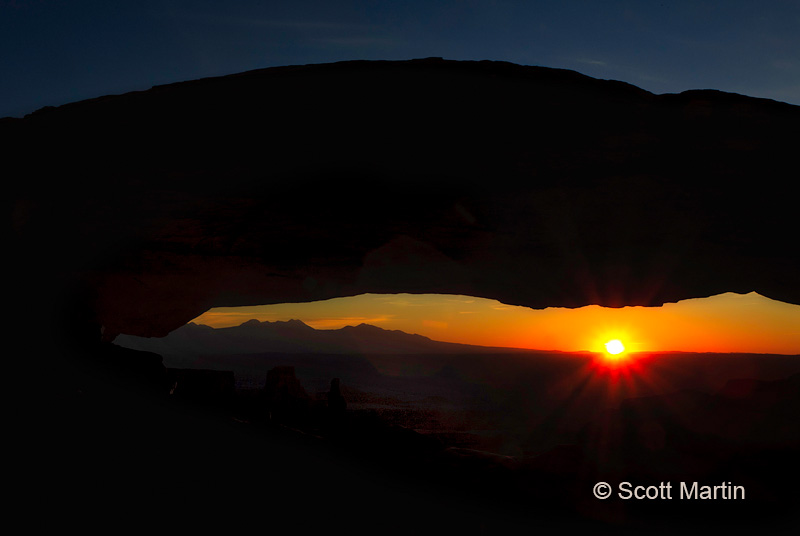
After the sunrise we had some time to explore around the arch and photograph it from many different angles. The following are a few of our favourites as well as some general shots to give you a sense of the area.
The underside of the arch literally starts to glow a few minutes before sunrise and is amazing to watch. In looking at the arch, my theory is that the glowing phenomenon is created by the early light reflecting off the cliff face upwards onto the underside of the arch which overhangs the 1800 foot precipice. The oxide rich sandstone makes the warm early light take on the even richer red & orange shades seen in the images. I think this next shot illustrates the point.
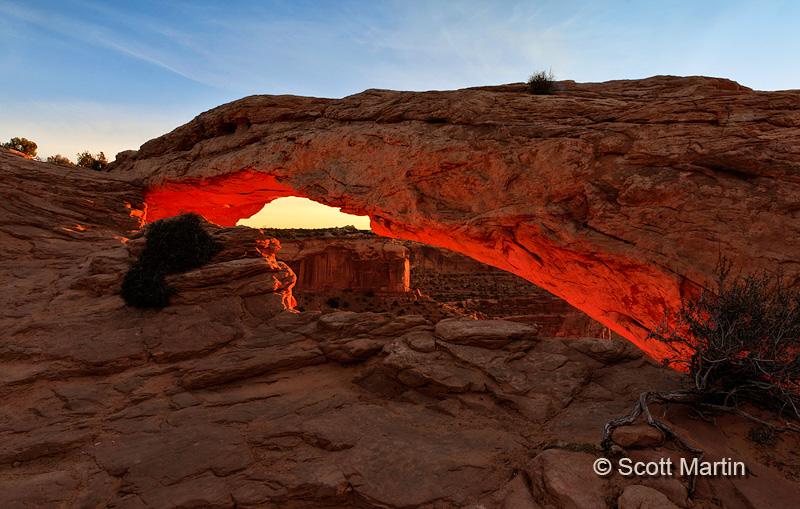
From the other direction.

A group shot!
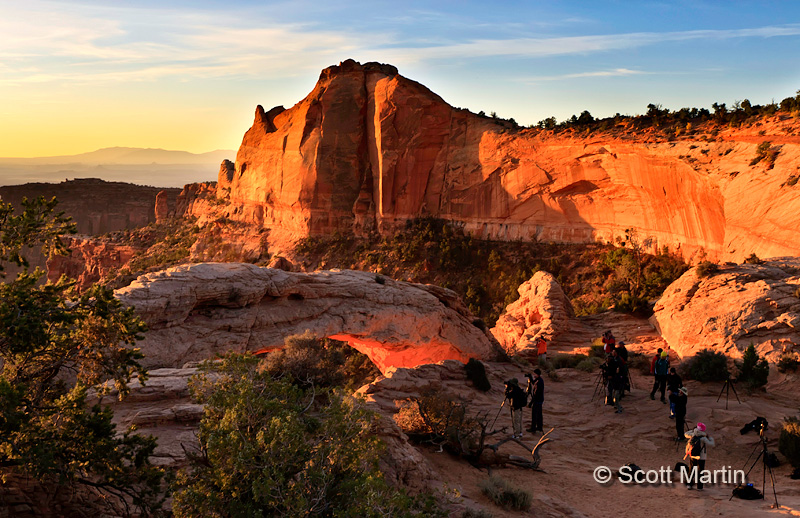
The arch from above (you can see a person at the top of the arch for perspective).
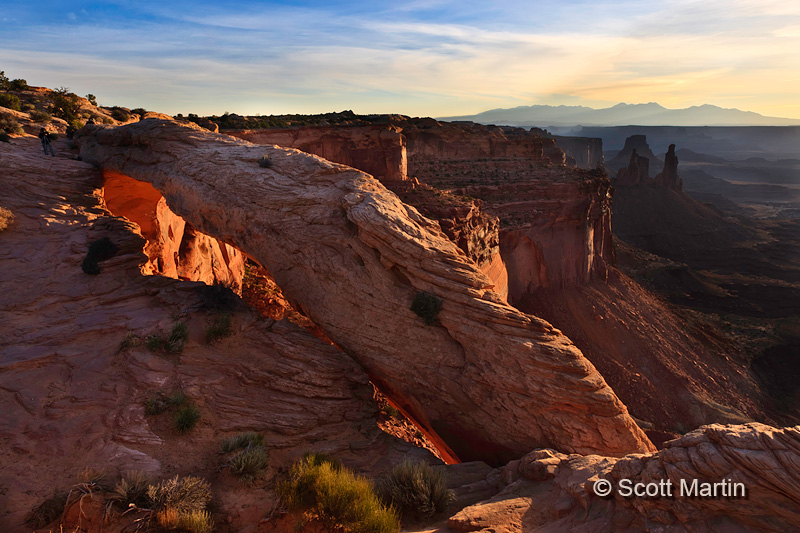
Finally some close-ups. The Mesa Arch is one of the most photographed arches on the planet so there are no unique or original shots to be taken, that said, you always try to take something that is a little bit different.
It seems that many of the rock formations have their own descriptive names. In the right central portion of the image below you can see three local landmarks. The ‘Washer Woman Arch’ is in silhouette in front of ‘Airport Tower’ and immediately left of ‘Monster Tower’.
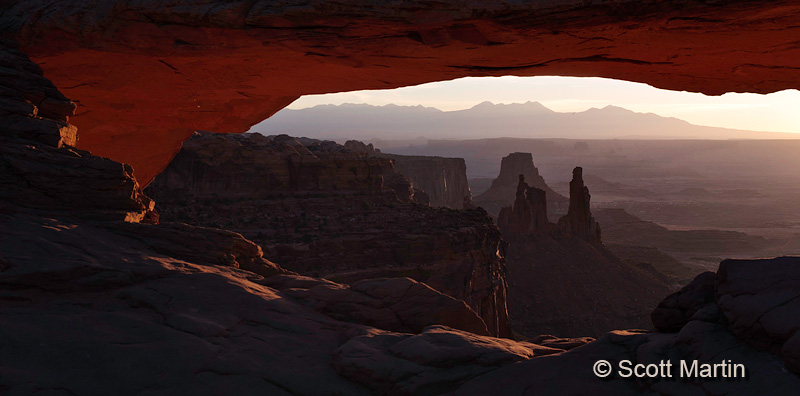
.
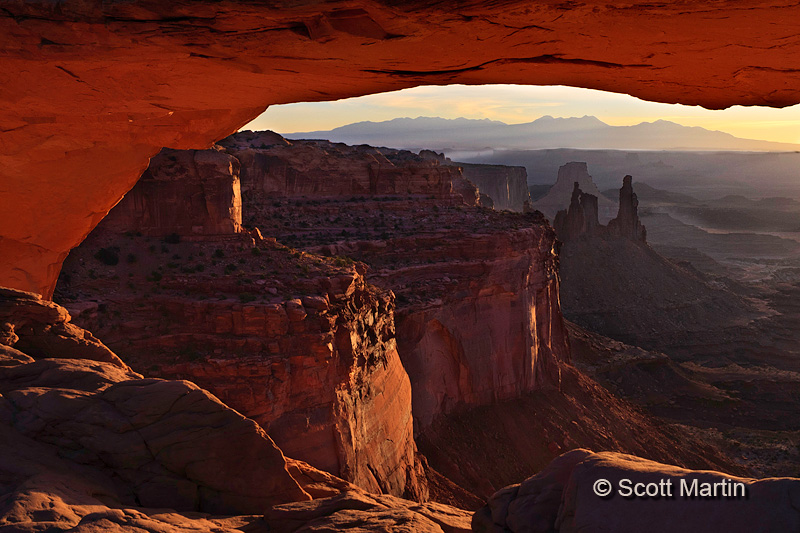
.
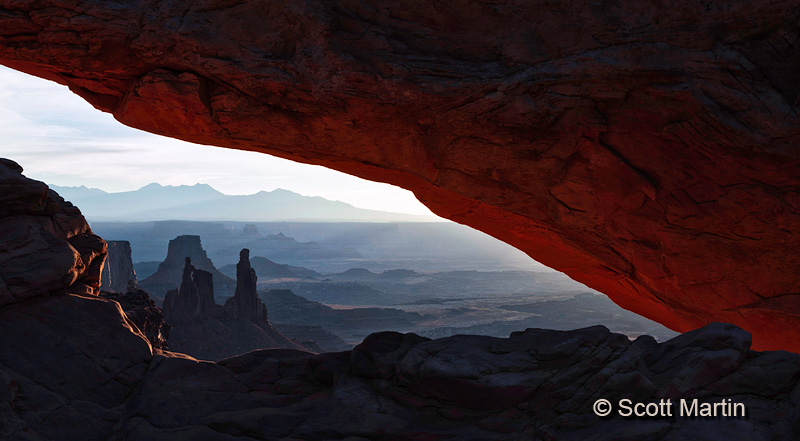
.

I trust these images have inspired you to plan a trip to Canyonlands National Park to experience a sunrise at the Mesa Arch.
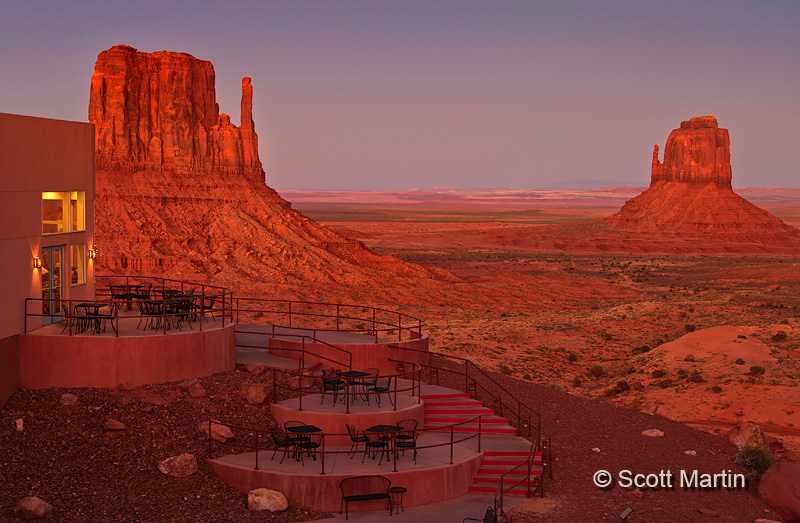
by Scott Martin Photography | Feb 24, 2012 | Blog, Landscapes, Naturescapes, Travel
Monument Valley is a vast area within the Colorado Plateau which is characterized by huge sandstone buttes and mittens, the largest of which are over one thousand feet high. Monument Valley is part of the Navajo lands and all of the images in this post were taken within the 92,000 acre Monument Valley Navajo Tribal Park. Monument Valley is entered off Hwy 163 just south of the Utah, Arizona border and a few miles west of the Four Corners. For the trivia buffs, the Four Corners is the only place in America where the borders of four states meet….Arizona, Utah, Colorado and New Mexico.
While in Monument Valley, Deb & I stayed in the The View Hotel which was a terrific spot and every room has a view like no other hotel you have ever stayed at. When in the area, this is the only place to stay if you want to capture incredible sunrises and sunsets without leaving your room. Here is a twilight image of the West and East Mittens (and hotel dining room entrance) taken from our balcony.

.
Monument Valley is a wonderful place to photograph; the awe-inspiring beauty of the landscape, the sheer size of the buttes & mittens and the dynamic light creates ever-changing colour hues within both rock and sky so each image is different from the other even though the object remains the same. The following images are an attempt to show case the three sandstone formations that comprise the famous Monument Valley Panorama; the West Mitten, East Mitten and Merrick Butte.
The first five images are sunsets.
The Mitten Buttes (West & East)
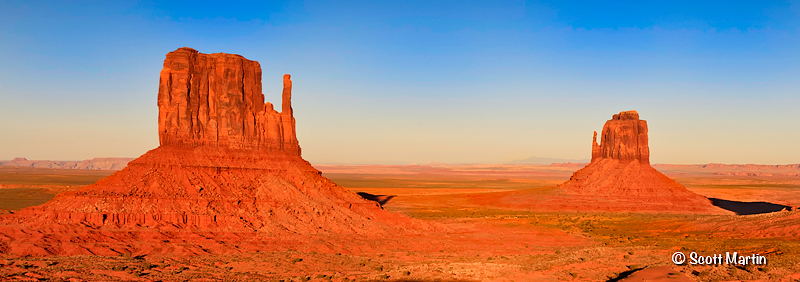
The West Mitten
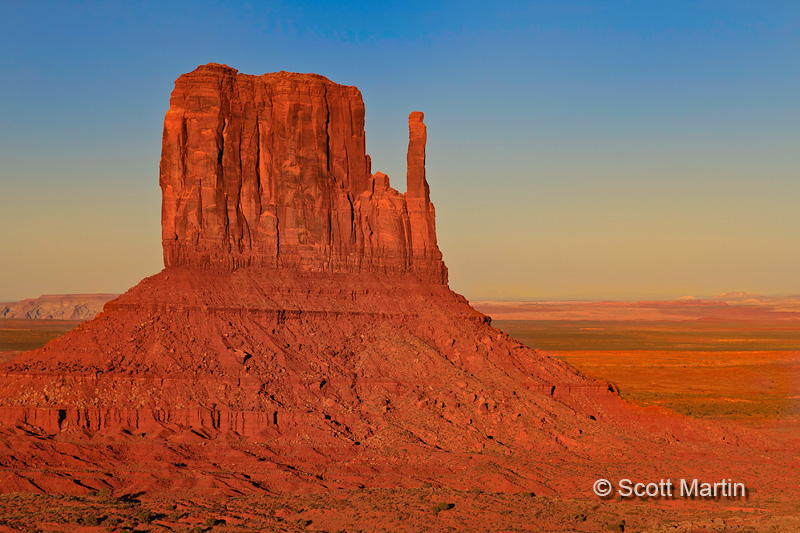
The East Mitten
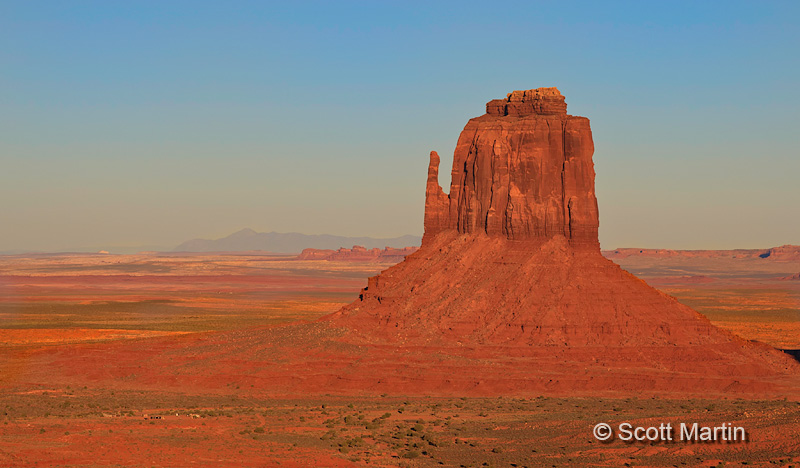
The East Mitten and Merrick Butte
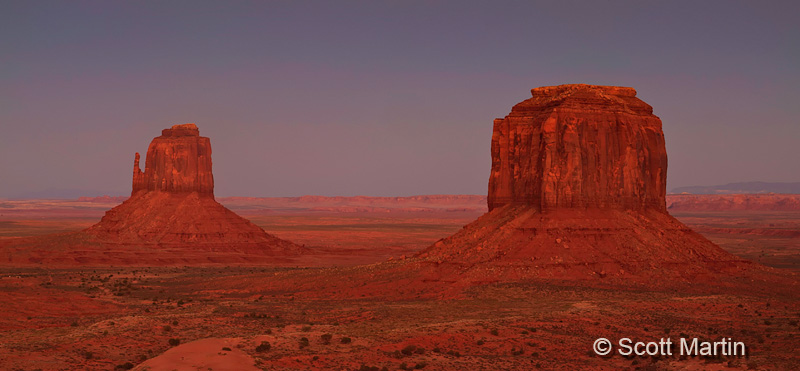
The same shot, different time, different sky….amazing!
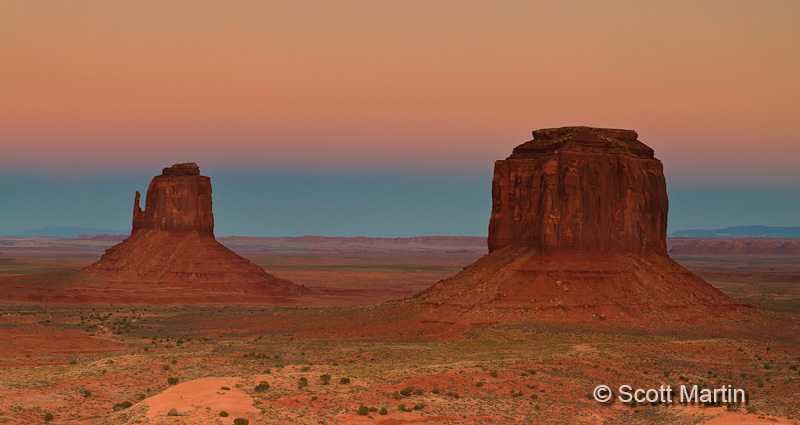
The following images are sunrise shots and as is often the case the photographs taken before sunrise are the ones that catch your eye.
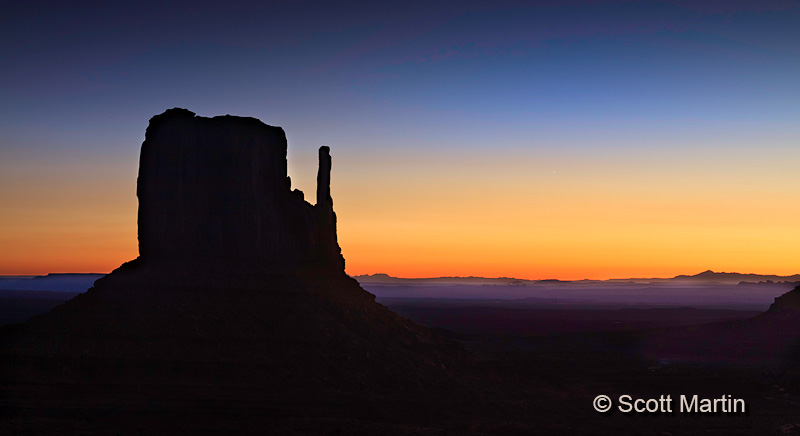
.
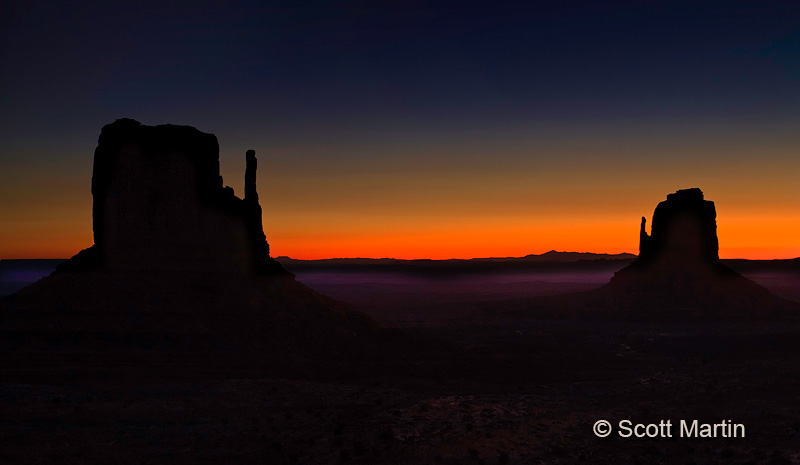
.
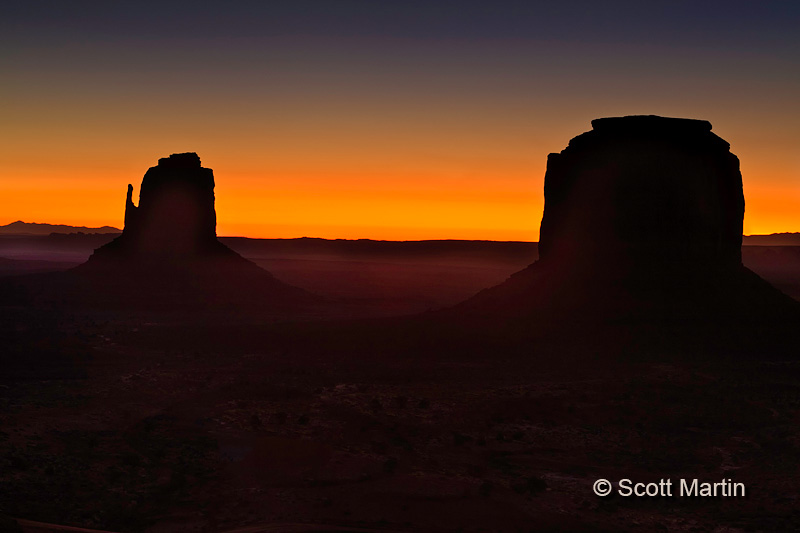
.
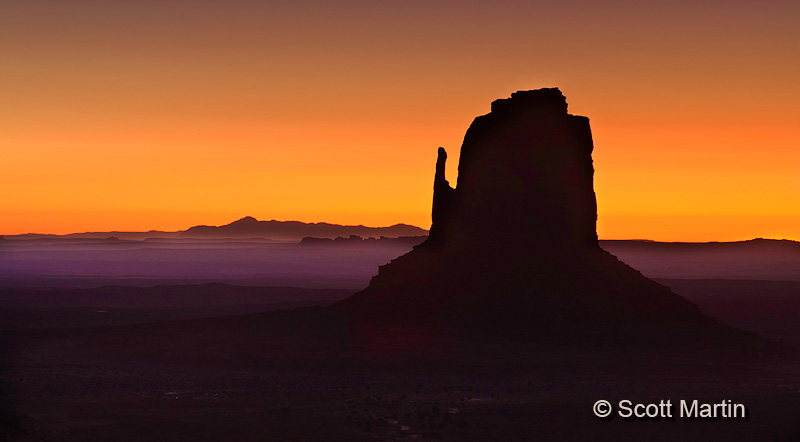
.
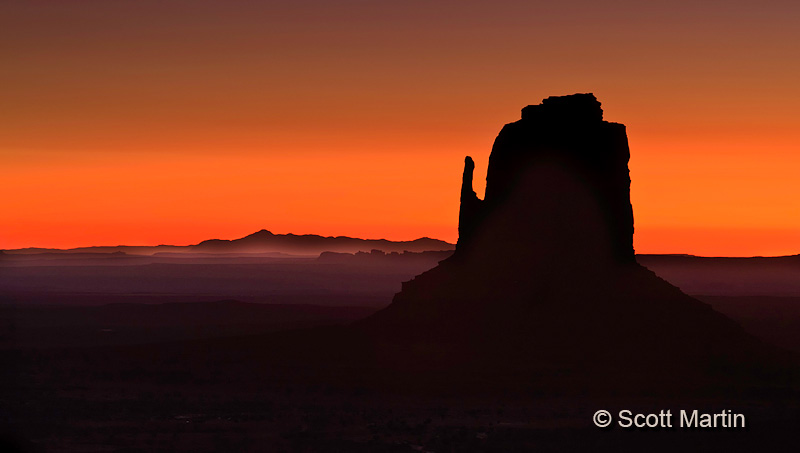
.
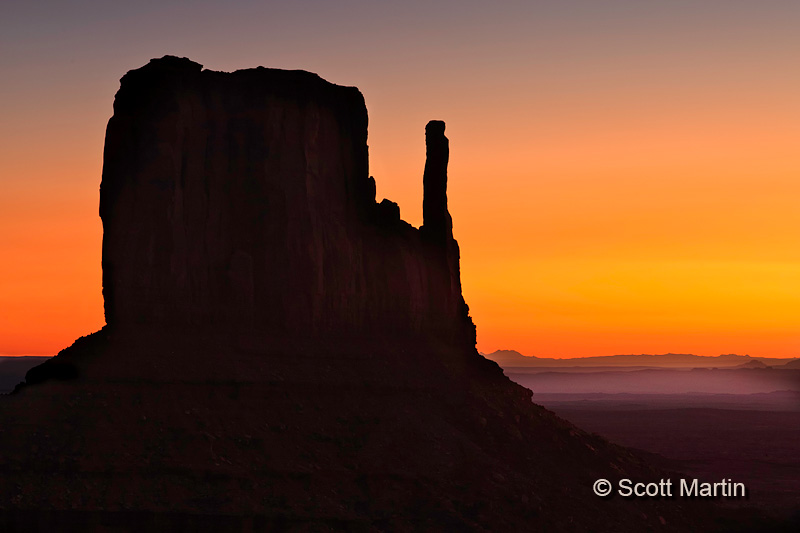
.
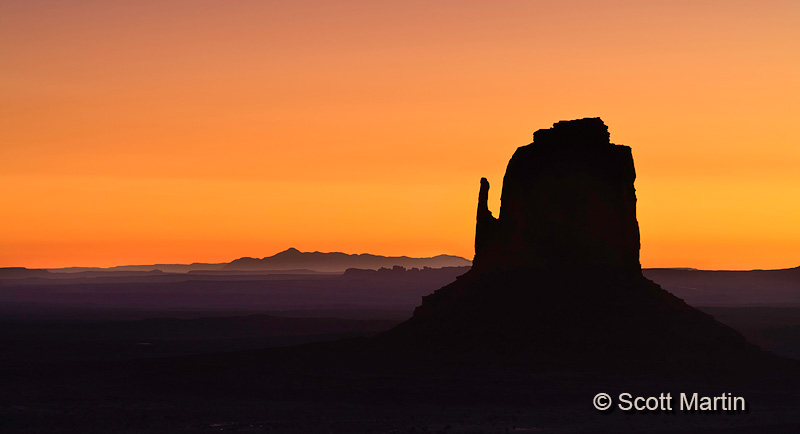
.
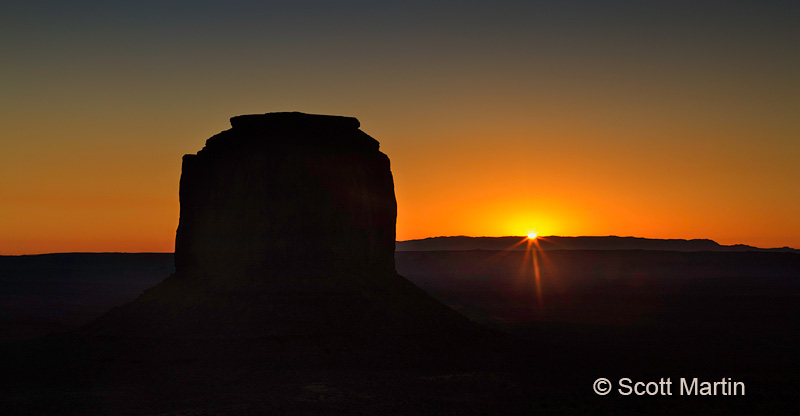
.
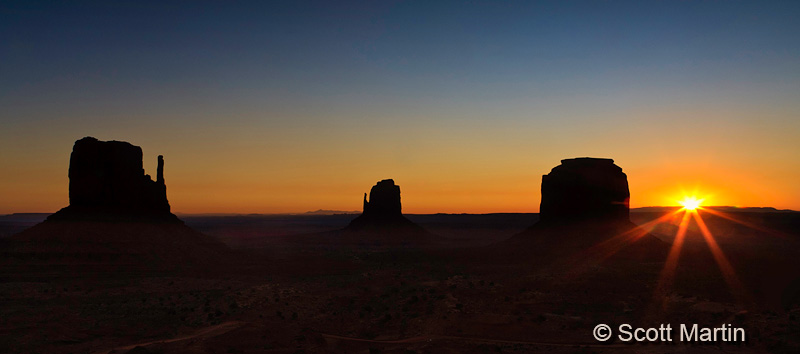
If memory serves me correctly these images were taken using three different lenses; 16-35/2.8; 24-105/4 and 70-200/2.8 Most of this series was also taken using 4×6 Lee ND Grad filters.
After watching the sunrise we headed out into the valley where there is a forty mile dirt road that winds its way around countless buttes, each one a great photographic opportunity, the result of which I’ll post another time. From Monument Valley we headed North along Highway 163 to Moab Utah and two more incredible National Parks; Canyonlands and Arches.
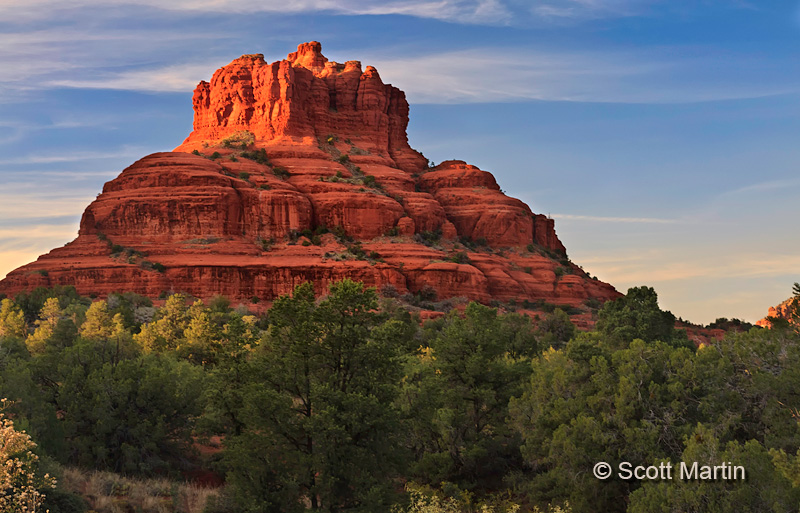
by Scott Martin Photography | Feb 21, 2012 | Blog
Photographers in general and landscape photographers specifically take most of their images in the early morning or late afternoon light. These times, for an hour or two after sunrise and the same before sunset are often referred to as the “Golden Hours”. When the sun is close to the horizon, the incident light travels farther through the atmosphere and more of it is refracted or scattered, losing some of the higher wavelengths (blues) leaving the lower wavelengths (reds) creating the typical pinkish sunrises and red/orange sunsets we enjoy so much. Also during the golden hours, the shadows are longer, the light is more even and the lighting ratios are reduced all of which combine for the great light which makes every image better than when shot in the harsher direct light of the mid-day.
The images in this post are taken in Sedona Arizona, which is located about two hours north of Phoenix Arizona and it’s where Deb & spent the first night of our five-day photo tour of the Grand Canyon area. Sedona is an absolutely beautiful town and the scenery is spectacular in all directions.
The five images are shown in chronological order, the first two being snap shots taken at the side of the road (Route 179) as we entered Sedona.

.
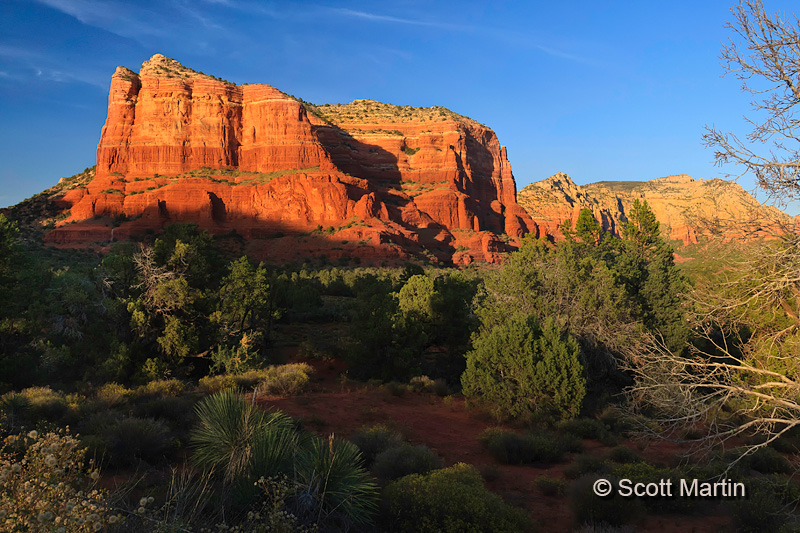
The next three sunset shots mark the transition from the golden hour to twilight. Twilight being the time between sunset and dusk when although the sun is below the horizon the sky retains its blue colour to the eye before transitioning to the blackness of night. “Night” photography should always be done during twilight while the sky retains some colour which serves to preserve the distinction between the objects and the sky. Once the sky is dark the boundary between the object and the background is lost resulting in a poor image.
The following images were taken from the top of Airport Road which climbs to a vantage point high above Sedona and is a popular place for people to gather and watch the spectacular sunsets. There were probably a hundred people there the evening we were including a number of serious photographers jostling for the best spot to set up a tripod. They were taken with a 16-35/2.8 zoom lens using Lee & Singh-Ray 4×6 ND gradient filters.
This next image is a favourite, taken just before sunset, and I wish you could see it full size. Our first night in Arizona was the only day we saw clouds in the sky.
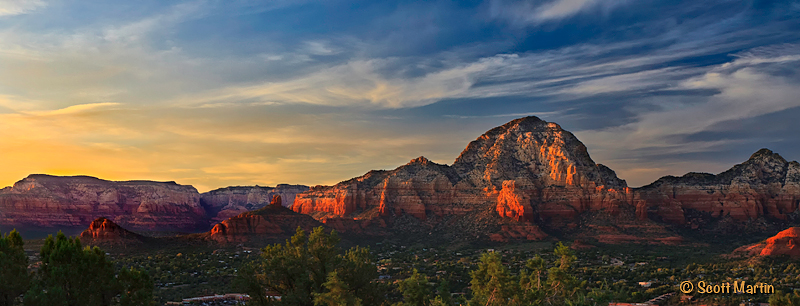
The next image was taken after sunset and by using a longer exposure captured more colour (reds/pinks) than would be seen while watching the sunset.
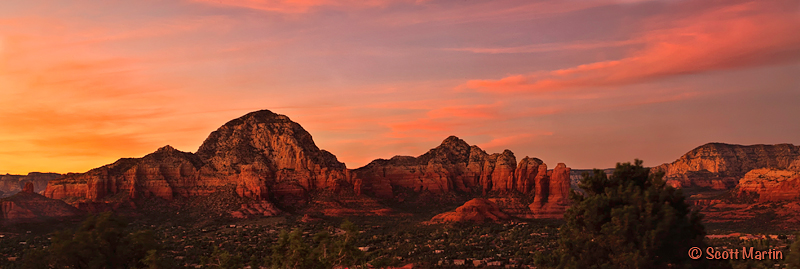
This last image was taken long after sunset when it was almost dark as you can tell by the lights in the Sedona Streets in the foreground. As in the previous image, an overly long exposure was used to get some light in the sky, which would have appeared almost dark when taking the photograph.
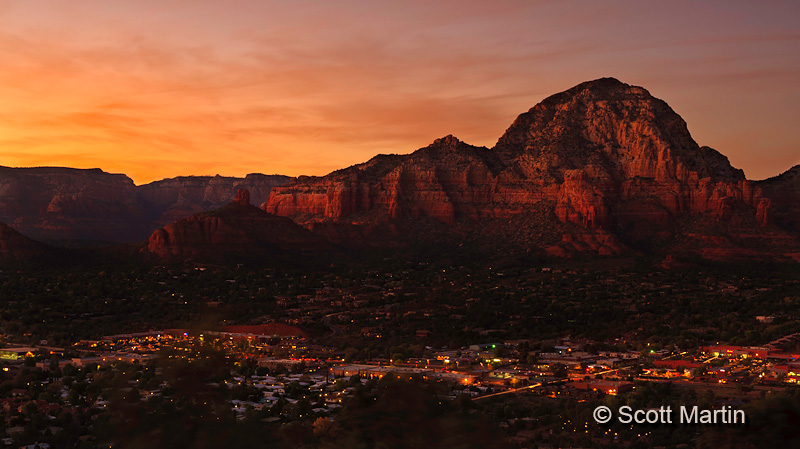
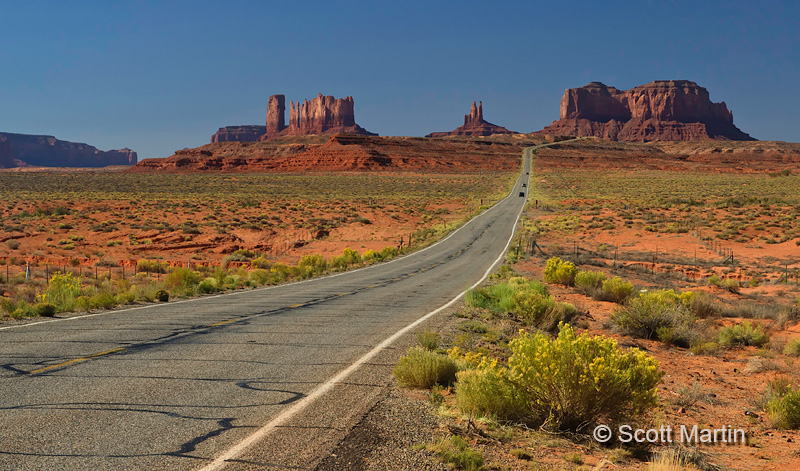
by Scott Martin Photography | Feb 17, 2012 | Blog, Landscapes, Naturescapes, Travel
Heading southwest towards Monument Valley on Route 163 near the Utah Arizona border you are greeted by one of the most iconic open road views in the country. Our first glimpse of this amazing vista was in the rear view mirror as we were heading North towards Moab at the time! No doubt you have seen pictures similar to the ones posted today, however I trust you also enjoy these. Please feel free to comment on them and let me know which perspectives you enjoy the best.
The five images to follow were all taken hand-held at focal lengths ranging from 16-105 mm, with the perception of the depth of the image being progressively compressed at the focal length increases. One of the ‘rules’ of wide-angle landscape photography is to have something of interest in both the foreground and background , however this creates a problem for shots like these where the topography is pretty nondescript save for the incredible buttes and mittens that are at least five miles away. To try to follow the rules of composition, I found the largest bush along the road side and positioned it in the foreground of the image, making sure to have the camera high enough that separation was maintained between the bush and the background rock formation.

This next shot was taken from the same general spot as the first image (you can see the bush used as foreground object in the last shot on the right side of this image as well). The only differences being focal length (24mm) and lower camera height to change the perspective making the road more prominant. For this shot I was lying down so the camera was only about six inches above the road. This image is a single frame, cropped to create the panoramic look.

The last three images attempt to find a pleasing balance of perspective and composition resulting in a great photograph, or moving the image from a snapshot to a photograph.
The next image is just a snapshot, taken with the camera at standing height from relatively close to the rock formation. Being too close to the background stops the road from disappearing into a long thin ribbon which takes a way the feeling of great distances and also reduces the ability to sense just how big the rock formations actually are. Both of these problems are compounded by the longer focal length chosen to take the image (105 mm).
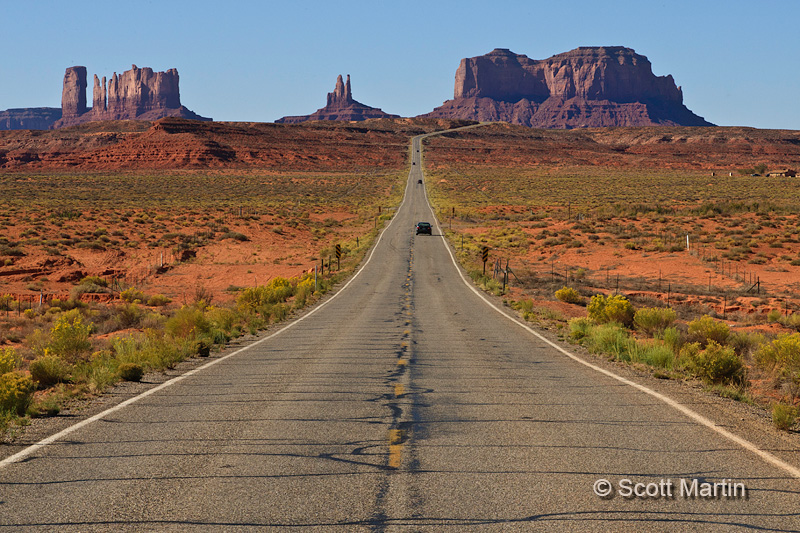
The last two shots come the closest to working well at conveying the feeling of what it was like to actually be there. The next image was taken from the farthest point away from the buttes which were about four or five kilometres away. It was taken standing to reduce the relative size of the road in the foreground and including a bend in the road to change the way your eyes are led towards the buttes and mittens in the background.
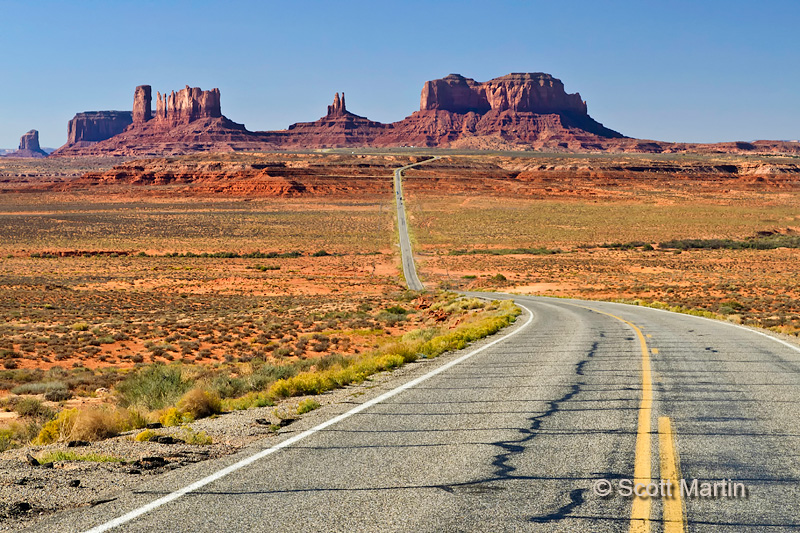
The last image is my favourite of this group. It was taken from a sitting position in the middle of the road to enlarge the presence of the road slightly as well as allowing the small berms on the roadside to provide some foreground interest. Plus the straight road into Monument Valley takes you immediately to the object of the image. The shot was taken at 65mm at f/16 at 1/100 sec.
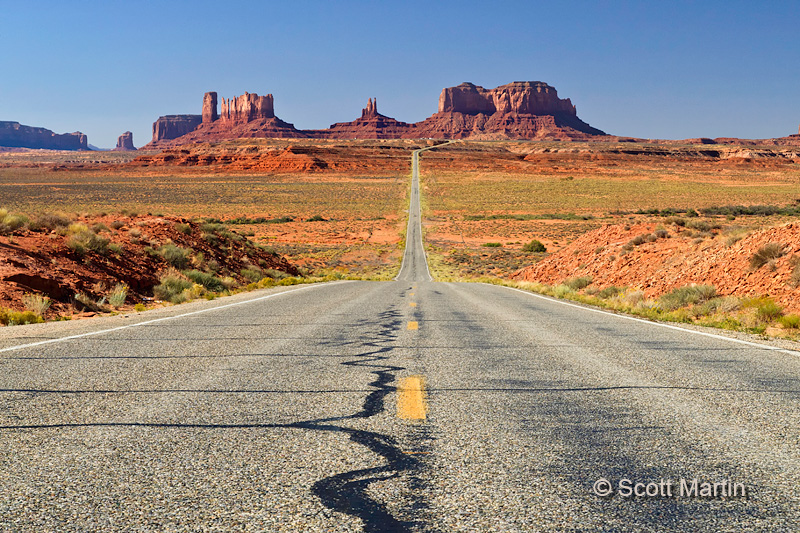
The enjoyment of an image is a purely subjective thing, we either like it, don’t like it or are ambivalent towards it. The trick with good photography is to deliver images that someone other than yourself actually likes! To do that we need to learn to always be thinking about the pictures we are taking, and then experimenting with different variations of the same scene like I’ve tried to demonstrate with these images of Monument Valley. The more thought one puts into the exercise before pressing the shutter really helps deliver consistently better images. It is so much easier to improve your skills in the digital age as CF cards are inexpensive and we can take lots of images in order to arrive at a couple of good ones. For this series Deb & I probably spent an hour or so stopping at four or five different spots along the highway and taking about seventy-five images.
If you haven’t already been there, plan a trip to Monument Valley. You will be glad you did!













































Follow Scott Martin Photography